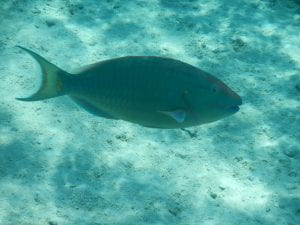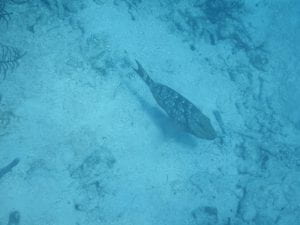Hi Blog,
After breakfast, we met in the wet lab in order to finish analyzing our parrotfish data from yesterday and to compile it all into a poster. Emily took on the visual illustrations for the four kinds of parrotfish surveyed in this project which looked amazing. We actually got the poster finished in under 2 hours which was a new record time. I think our poster devising and presenting skills have definitely leveled up during our time here in Belize.

During the poster presentation out on the dock though, Elise’s hat got blown into the ocean, which then she immediately dived in to save. Little did I know, she would not be the only one jumping in the ocean to save her cap…

After the poster, we went to the mangroves and seagrass to catch any organisms we could find. We found grass, some crustaceans, arthropods, small anchovy-like fish, and a snail. We had tools such as two small nets, two trays (one of them had two trays stuck together), and some tongs to aid us in our harvest, but the process was very difficult regardless. At one point though, Claire D caught four of the small fish back to back to back which was so impressive! I tried to catch them with my hands, but they were too fast for me… After our harvest was over, we went back to the wet lab to take a closer look at the samples. I was especially intrigued to look at the snail (that Lily caught) under the microscope, as I could see it moving within the shell.
After this, we had sandwiches for lunch which was absolutely delicious. Then, at 1:30 PM, the class took a trip to the coral graveyards. We got to see countless fossilized/calcified corals, such as brain corals, staghorn corals, seafan, and even a conch. It was incredibly powerful to see the contrast between the vibrantly colored human plastic pollution and the black/white fossilized corals. It truly reminded me of the consequences of anthropogenic actions on the environment, and it was eye-opening to see that with my very own eyes.

Around 3 PM, we began presentations starting off with Claire C’s taxon presentation about sharks and rays. But the power shut off towards the end of her lecture, so the rest of the presentations were postponed until 5 PM. In the meantime, some of us went to the dock to lay down and sunbath, and my hat got blown off by the wind into the ocean. I, left with no other choice, jumped in and swam to retrive my poor hat.
At 5 PM, we resumed with the rest of the presentations, such as Emily’s piscivorous fish presentation and Ian’s topic lecture about the evolution and ecology of angelfish.
We then had dinner, which was chicken soup with rice. I added some hot sauce in it to add a little kick, and it was perfect.
After, at 7:30 PM, the class met up for an optional night fishing, since night snorkeling had gotten canceled due to the strong winds making the snorkeling conditions rather unsafe. I didn’t have much expectations for it since our tools were a hanging dive light and two tiny nets, but to my surprise, our class did a spectacular job! Not only did we catch several shrimp and small fish, but we also caught a glass eel and a squid!! The glass eel was very silly to look at as it looked like a clear noodle with cartoon eyes. The highlight though, was the squid caught by Claire D. We put it in a bucket for observation, and we actually watched it squirt ink, which turned the entire bucket black! Also, when we were playing around with it with the net, the squid actually changed colors to camouflage with its own ink speckles!
Since today was mainly land-based, there was no surgeonfish spotting, but maybe I will be able to see one again tomorrow!
I’m not quite sure what the day will look like tomorrow, but I will keep you guys updated! 🙂
























